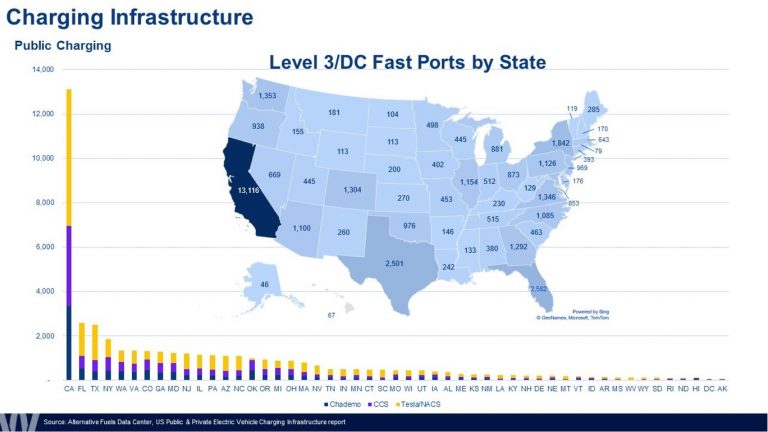One of the more challenging aspects of the transition to electrification is to fully understand and internalize the changes that EVs will precipitate. The reason is something I call the “Petroleum Paradigm”. We’ve been living with ICE vehicles since long before any of us were born, and in that time, we created a wide variety of habits, methods and means to optimize our work and personal lives based on the strengths and weaknesses of gasoline as an energy source. It’s so ingrained in us, we no longer think of it in those terms, it’s just “The Way Things Are”.
I speak to a lot of clients about their electrification strategies, particularly in the early stages, and I can tell pretty quickly when a client is still boxed in by the Petroleum Paradigm. For example, I’ll be in an initial meeting with a client, and all their questions are focused around public charging. Not that these aren’t legitimate questions (they are), but a heavy focus on public charging tells me you’re thinking of EVs as gasoline vehicles with electric motors. They’re not. They have a completely different energy source, and if you try to shoehorn EVs into the Petroleum Paradigm, you will be dissatisfied with the results. If you’re relying on public charging as your primary charging strategy (gas station style model), you’re doing EVs wrong.
It’s easy to see how this happens. When we were kids, we rode in the car with mom and dad as they went to the gas station to fuel up the family car. Then, we got our driver’s license and first car, and we fueled in the same manner. Today, for our kids and grandkids it’s still the same. It’s just The Way Things Are.
A Little History Lesson—what’s old is new again
Sorry about the history lesson—this is the point where my kids roll their eyes—so stay with me, I do have a point to make.
In the early 20th century, electric vehicles (EVs) were a significant part of the automotive landscape. They enjoyed popularity due to their quiet operation, ease of use, and lack of emissions compared with the noisy and polluting internal combustion engine (ICE) vehicles. Women liked them (Henry Ford’s wife drove one) because they were easy to start (no cranking) and cleaner. Early EVs were especially favored in urban areas for short commutes. This was a time when cities were electrified, but not suburban or rural areas where the roads weren’t paved. In the US in 1910, 28% of cars were electric, 38% were steam powered, and 34% were gas powered. With roads outside cites being pretty rough, range was initially not an issue. At this point, the direction of the industry was in question.
But with the 1916 Federal Aid Road Act, road infrastructure improved. At that time, electricity was still generally not available outside cities, while gasoline is portable and could be carried in cans. At about the same time, mass production of ICE vehicles began and they became progressively much cheaper than EVs. The aligning of these events played a significant role. So, the lack of adequate charging infrastructure (almost none), the invention of the electric starter for ICE vehicles in 1912 and cheaper mass-produced gasoline vehicles determined the future. Gas stations were erected along the developing road system. In those days, greenhouse gases weren’t really a concern.
My point is that there are many factors, including the timing of other developments, in play for any new technology. Amazon was not built in a day. Mindsets need to adapt to change.
Taking on a “Change Mindset”
The electrified future will not be as we know things today. This became readily apparent to me on a recent trip to California, where I myself fell into the Petroleum Paradigm trap.
In early November, I was one of the Wheels presenters during our EV Summit. I gave an update on infrastructure progress in the US and showed this slide below.

The slide shows the number of installed Level 3 chargers by state, and as you can see, California is like a different planet compared to the rest of the country with as many installed chargers as the next eight highest states combined. A couple weeks after the summit, the Fleet Forward conference was held in Santa Clara, CA. It had been probably about 5 years since I had last been to California, and the number of installed chargers had grown substantially since then. I live in the suburbs north of Atlanta, Georgia, and although Georgia has made significant strides in charging infrastructure, it’s not easy to find a charger. They’re there, but they’re also not commonplace and definitely not noticeable when driving around. I was expecting to get a peek at the electrified future during my trip to California.
After landing in San Jose airport, I took a Lyft to the hotel. I purposely avoided opening my app identifying nearby chargers, because I wanted to see how visible they were in just driving through town. To my surprise, I didn’t see any. I saw plenty of gas stations (as expected), but no charging stations. Where were they?
Frustrated, I opened my app to find any nearby charging stations, and immediately my screen exploded as they popped up like mushrooms after a spring rain. They were everywhere around me, but also not visible.
This puzzled me for a moment, before I laughed as it struck me that I had fallen into the same trap I try to warn clients about. I was expecting to see charging stations in California like we see gas stations today. Big, gleaming stations on multiple street corners with dozens of chargers. The reality was far different. Why wasn’t it like I expected?
Do you know why we have these dedicated places that sell gasoline (gas stations), and not a gas pump in every home? It’s because gasoline is nasty, dangerous stuff. It’s volatile, highly flammable, poisonous and corrosive. In fact, going back to our history lesson, early ICE vehicles were prone to fires. Today, we don’t notice how dangerous gasoline is because we benefit from decades of government protections and regulations around the sale, transport and dispensation of gasoline making it relatively safe. Gas stations are full of signs and warnings about this, but we don’t notice them anymore. It’s all just The Way Things Are.
Gas stations and our entire transportation network works because it’s been optimized around the strengths and weaknesses of gasoline as an energy source. It’s a liquid so it’s easily transferable and very energy dense. Gas stations mitigate the weaknesses, the inherent danger of gasoline, making it safe for the general public. Our entire fueling dynamic and transportation infrastructure has been predicated around the strengths and weaknesses of gasoline as an energy source.
The Strength and Weaknesses of Electricity
The strengths and weaknesses of electricity as an energy source are completely different. The weakness is obvious. It takes a long time to charge a battery (at low voltages). Even at high voltages (DC Fast or Level 3), it still takes much longer than replenishing a fuel tank. Electricity does have a very big advantage though. It’s available pretty much everywhere. It’s quite literally all around us at pretty much any time. You can fuel your EV at any home, business, church or community property. Even at a campground. If it’s man made, there’s a good chance it will have electricity. All that’s needed is an outlet to plug into, and the time to charge.
This is the crux of the Petroleum Paradigm. We’re so ingrained with a gas-station style fueling experience, it’s difficult for us to imagine that not only does it not have to be this way, it’s actually counterproductive to the strengths and weaknesses of electricity as an energy source.
This paradigm will slowly change, as it explains why I didn’t see big, gleaming charging stations in my trip to California. The new paradigm will be charging stations where vehicles are parked for extended periods of time. Charging stations in homes, parking garages, workplaces, malls, hotels, restaurants and more will become the new paradigm. It will be good business to offer them. Public charging stations will still be needed, but primarily for long trips, where you’re traveling further than the maximum range of your vehicle. This is a vanishingly rare occurrence for most Americans, with 90% of all trips going less than 50 miles. Think highway rest stops, or other major transportation corridors predominately.
Fleet vehicles will be no different. For drivers with take home vehicles, home charging makes the most sense, both in quality of life for the driver and economically. For vehicle depots, charging will need to occur there. Even if you don’t presently have on-site gasoline fueling, you’ll be adding on-site charging. If that’s not possible at your present location, creative thinking may be required because you will need to charge those vehicles during the hours they’re not in use. For drivers living in apartments or otherwise unable to have charging from their home, wherever their vehicle is parked overnight is where they will need to charge. New infrastructure, along with a new mindset will be required to satisfy this new dynamic.
I’m not suggesting any of this will be easy. It’s a new dynamic for all of us, and identifying how you and your fleet can take advantage of the strength of electricity as an energy source might be a simple, straightforward solution, or it might require some creative thinking. Either way, Wheels can help, and will be right there with you. Together Let’s Go Far.

Senior Product Manager